Major Theories of Construction Accident Causation Models
VerifiedAdded on 2023/06/10
|6
|1909
|273
AI Summary
This research paper discusses the common accidents, and injuries in the construction industry, and overcome hazards, and accident of construction workers. It also explains about accidents, injuries, and hazards of construction industries.
Contribute Materials
Your contribution can guide someone’s learning journey. Share your
documents today.
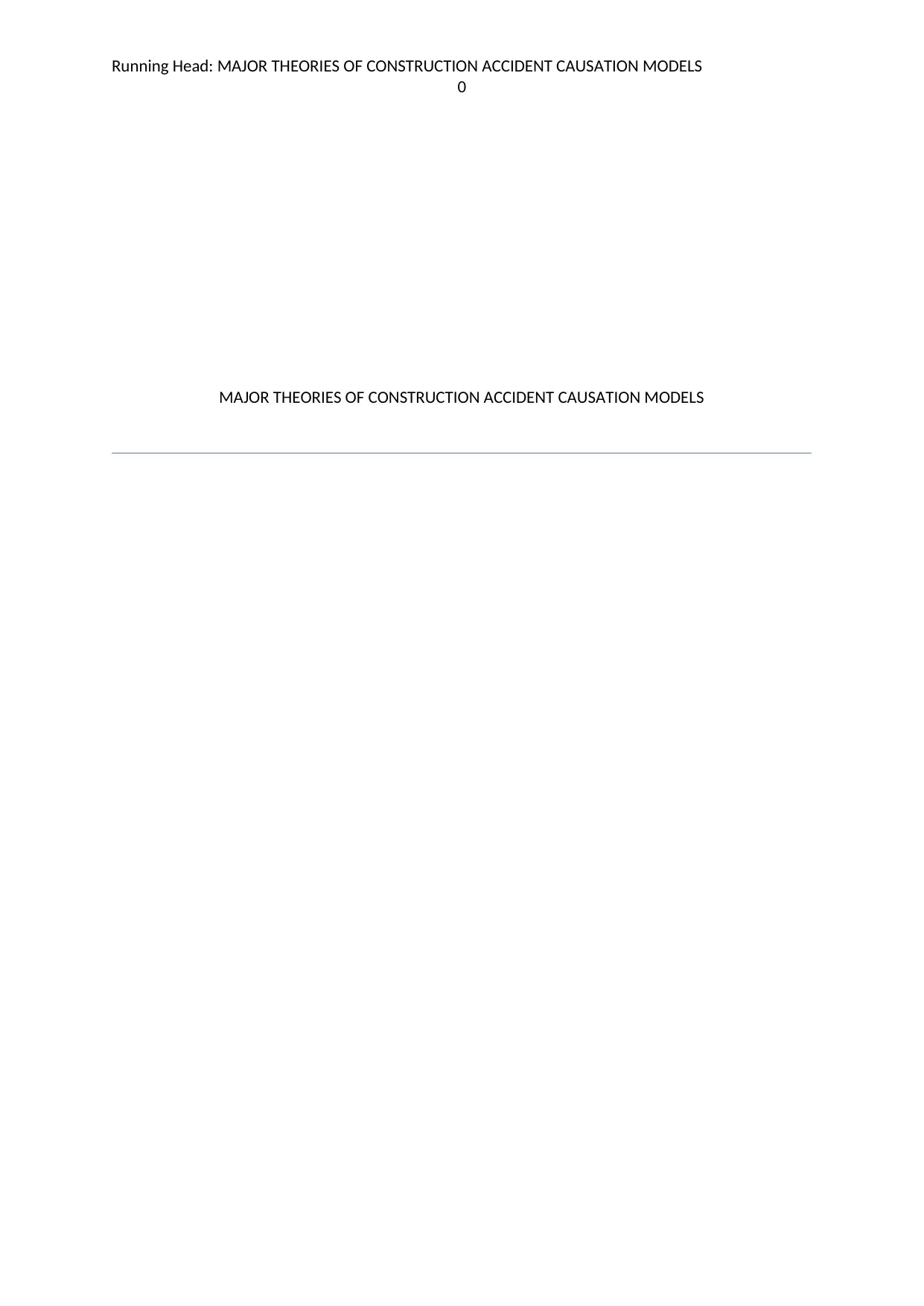
Running Head: MAJOR THEORIES OF CONSTRUCTION ACCIDENT CAUSATION MODELS
0
MAJOR THEORIES OF CONSTRUCTION ACCIDENT CAUSATION MODELS
0
MAJOR THEORIES OF CONSTRUCTION ACCIDENT CAUSATION MODELS
Secure Best Marks with AI Grader
Need help grading? Try our AI Grader for instant feedback on your assignments.
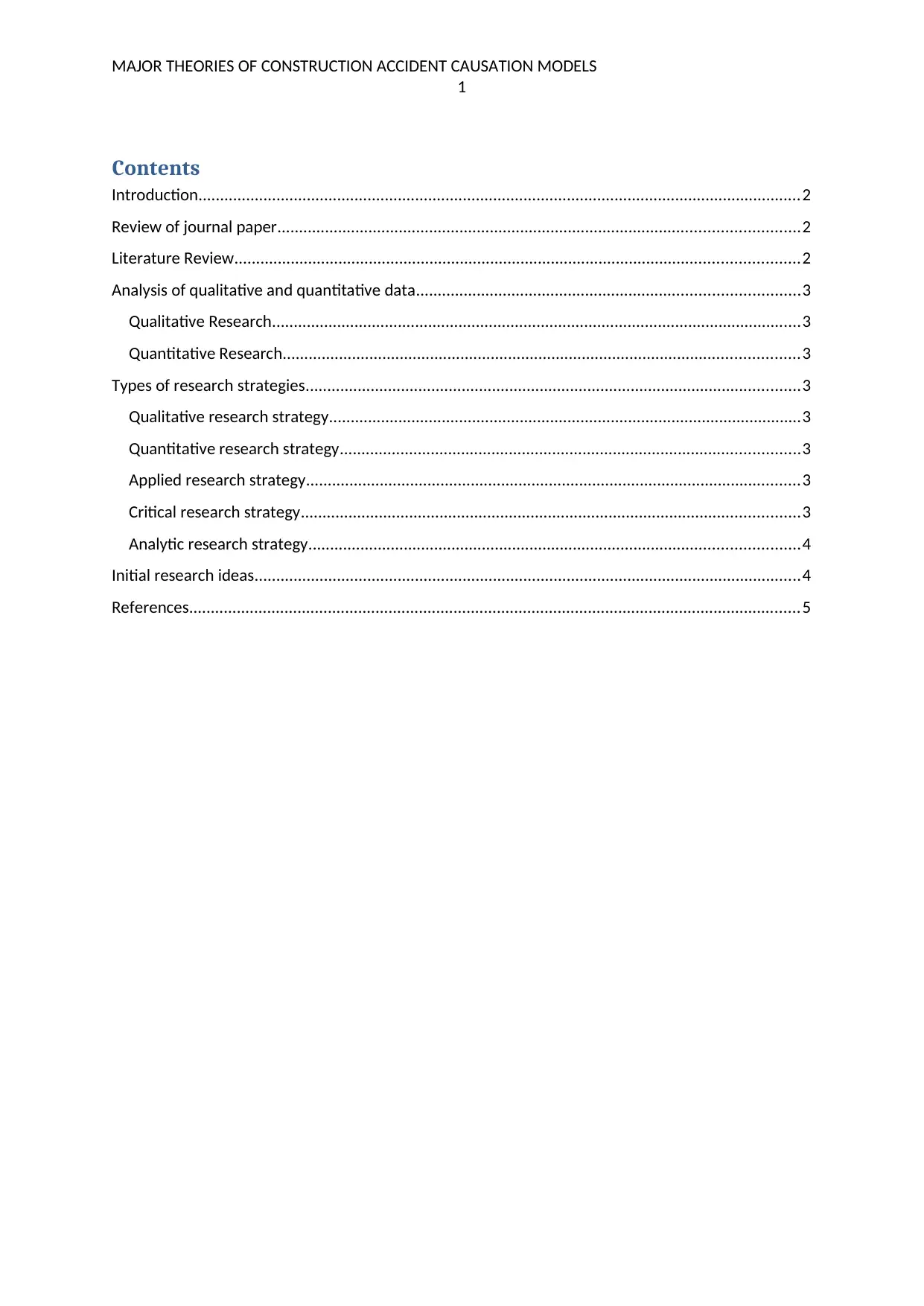
MAJOR THEORIES OF CONSTRUCTION ACCIDENT CAUSATION MODELS
1
Contents
Introduction...........................................................................................................................................2
Review of journal paper........................................................................................................................2
Literature Review..................................................................................................................................2
Analysis of qualitative and quantitative data........................................................................................3
Qualitative Research..........................................................................................................................3
Quantitative Research.......................................................................................................................3
Types of research strategies..................................................................................................................3
Qualitative research strategy.............................................................................................................3
Quantitative research strategy..........................................................................................................3
Applied research strategy..................................................................................................................3
Critical research strategy...................................................................................................................3
Analytic research strategy.................................................................................................................4
Initial research ideas..............................................................................................................................4
References.............................................................................................................................................5
1
Contents
Introduction...........................................................................................................................................2
Review of journal paper........................................................................................................................2
Literature Review..................................................................................................................................2
Analysis of qualitative and quantitative data........................................................................................3
Qualitative Research..........................................................................................................................3
Quantitative Research.......................................................................................................................3
Types of research strategies..................................................................................................................3
Qualitative research strategy.............................................................................................................3
Quantitative research strategy..........................................................................................................3
Applied research strategy..................................................................................................................3
Critical research strategy...................................................................................................................3
Analytic research strategy.................................................................................................................4
Initial research ideas..............................................................................................................................4
References.............................................................................................................................................5
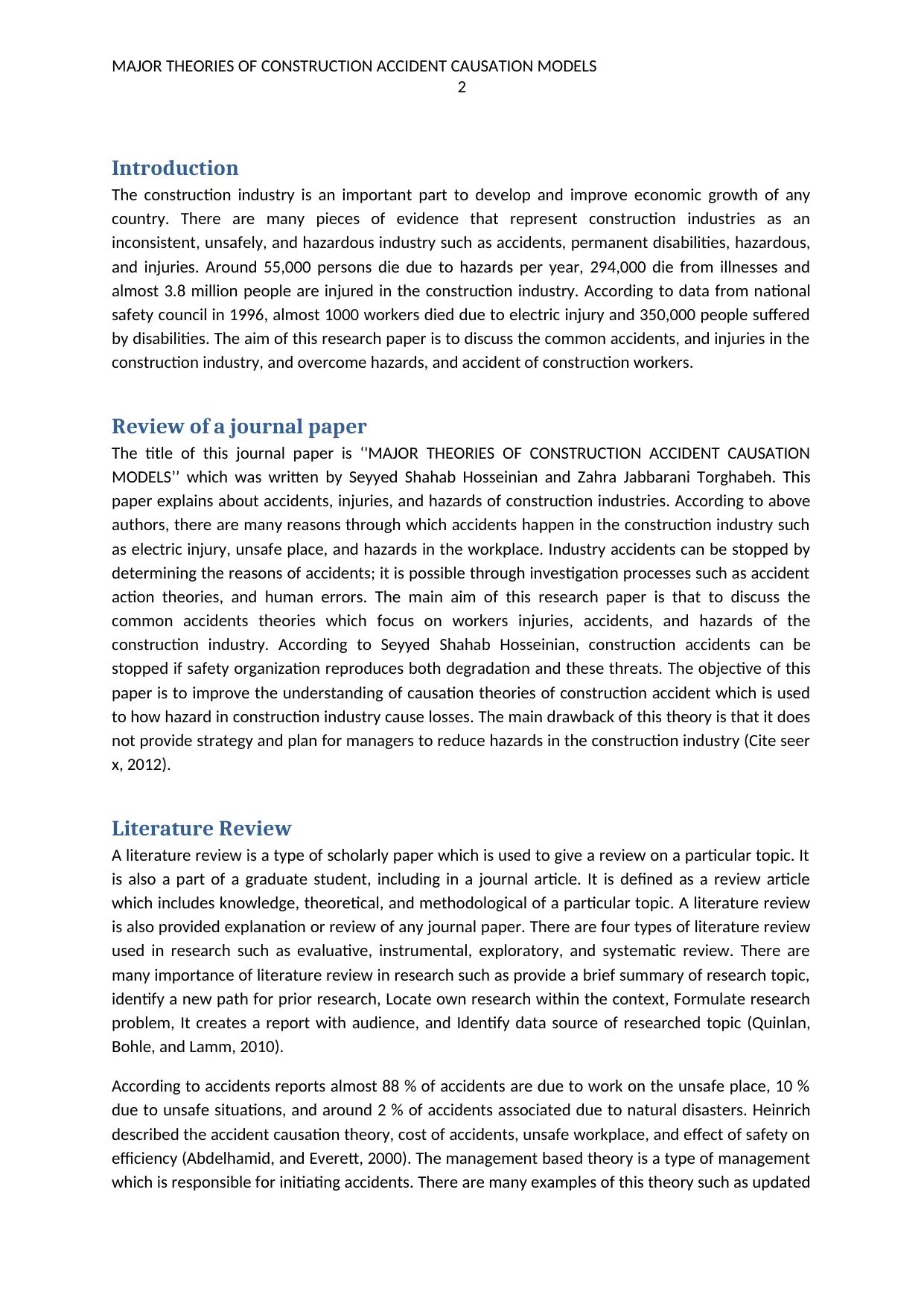
MAJOR THEORIES OF CONSTRUCTION ACCIDENT CAUSATION MODELS
2
Introduction
The construction industry is an important part to develop and improve economic growth of any
country. There are many pieces of evidence that represent construction industries as an
inconsistent, unsafely, and hazardous industry such as accidents, permanent disabilities, hazardous,
and injuries. Around 55,000 persons die due to hazards per year, 294,000 die from illnesses and
almost 3.8 million people are injured in the construction industry. According to data from national
safety council in 1996, almost 1000 workers died due to electric injury and 350,000 people suffered
by disabilities. The aim of this research paper is to discuss the common accidents, and injuries in the
construction industry, and overcome hazards, and accident of construction workers.
Review of a journal paper
The title of this journal paper is ‘'MAJOR THEORIES OF CONSTRUCTION ACCIDENT CAUSATION
MODELS’’ which was written by Seyyed Shahab Hosseinian and Zahra Jabbarani Torghabeh. This
paper explains about accidents, injuries, and hazards of construction industries. According to above
authors, there are many reasons through which accidents happen in the construction industry such
as electric injury, unsafe place, and hazards in the workplace. Industry accidents can be stopped by
determining the reasons of accidents; it is possible through investigation processes such as accident
action theories, and human errors. The main aim of this research paper is that to discuss the
common accidents theories which focus on workers injuries, accidents, and hazards of the
construction industry. According to Seyyed Shahab Hosseinian, construction accidents can be
stopped if safety organization reproduces both degradation and these threats. The objective of this
paper is to improve the understanding of causation theories of construction accident which is used
to how hazard in construction industry cause losses. The main drawback of this theory is that it does
not provide strategy and plan for managers to reduce hazards in the construction industry (Cite seer
x, 2012).
Literature Review
A literature review is a type of scholarly paper which is used to give a review on a particular topic. It
is also a part of a graduate student, including in a journal article. It is defined as a review article
which includes knowledge, theoretical, and methodological of a particular topic. A literature review
is also provided explanation or review of any journal paper. There are four types of literature review
used in research such as evaluative, instrumental, exploratory, and systematic review. There are
many importance of literature review in research such as provide a brief summary of research topic,
identify a new path for prior research, Locate own research within the context, Formulate research
problem, It creates a report with audience, and Identify data source of researched topic (Quinlan,
Bohle, and Lamm, 2010).
According to accidents reports almost 88 % of accidents are due to work on the unsafe place, 10 %
due to unsafe situations, and around 2 % of accidents associated due to natural disasters. Heinrich
described the accident causation theory, cost of accidents, unsafe workplace, and effect of safety on
efficiency (Abdelhamid, and Everett, 2000). The management based theory is a type of management
which is responsible for initiating accidents. There are many examples of this theory such as updated
2
Introduction
The construction industry is an important part to develop and improve economic growth of any
country. There are many pieces of evidence that represent construction industries as an
inconsistent, unsafely, and hazardous industry such as accidents, permanent disabilities, hazardous,
and injuries. Around 55,000 persons die due to hazards per year, 294,000 die from illnesses and
almost 3.8 million people are injured in the construction industry. According to data from national
safety council in 1996, almost 1000 workers died due to electric injury and 350,000 people suffered
by disabilities. The aim of this research paper is to discuss the common accidents, and injuries in the
construction industry, and overcome hazards, and accident of construction workers.
Review of a journal paper
The title of this journal paper is ‘'MAJOR THEORIES OF CONSTRUCTION ACCIDENT CAUSATION
MODELS’’ which was written by Seyyed Shahab Hosseinian and Zahra Jabbarani Torghabeh. This
paper explains about accidents, injuries, and hazards of construction industries. According to above
authors, there are many reasons through which accidents happen in the construction industry such
as electric injury, unsafe place, and hazards in the workplace. Industry accidents can be stopped by
determining the reasons of accidents; it is possible through investigation processes such as accident
action theories, and human errors. The main aim of this research paper is that to discuss the
common accidents theories which focus on workers injuries, accidents, and hazards of the
construction industry. According to Seyyed Shahab Hosseinian, construction accidents can be
stopped if safety organization reproduces both degradation and these threats. The objective of this
paper is to improve the understanding of causation theories of construction accident which is used
to how hazard in construction industry cause losses. The main drawback of this theory is that it does
not provide strategy and plan for managers to reduce hazards in the construction industry (Cite seer
x, 2012).
Literature Review
A literature review is a type of scholarly paper which is used to give a review on a particular topic. It
is also a part of a graduate student, including in a journal article. It is defined as a review article
which includes knowledge, theoretical, and methodological of a particular topic. A literature review
is also provided explanation or review of any journal paper. There are four types of literature review
used in research such as evaluative, instrumental, exploratory, and systematic review. There are
many importance of literature review in research such as provide a brief summary of research topic,
identify a new path for prior research, Locate own research within the context, Formulate research
problem, It creates a report with audience, and Identify data source of researched topic (Quinlan,
Bohle, and Lamm, 2010).
According to accidents reports almost 88 % of accidents are due to work on the unsafe place, 10 %
due to unsafe situations, and around 2 % of accidents associated due to natural disasters. Heinrich
described the accident causation theory, cost of accidents, unsafe workplace, and effect of safety on
efficiency (Abdelhamid, and Everett, 2000). The management based theory is a type of management
which is responsible for initiating accidents. There are many examples of this theory such as updated
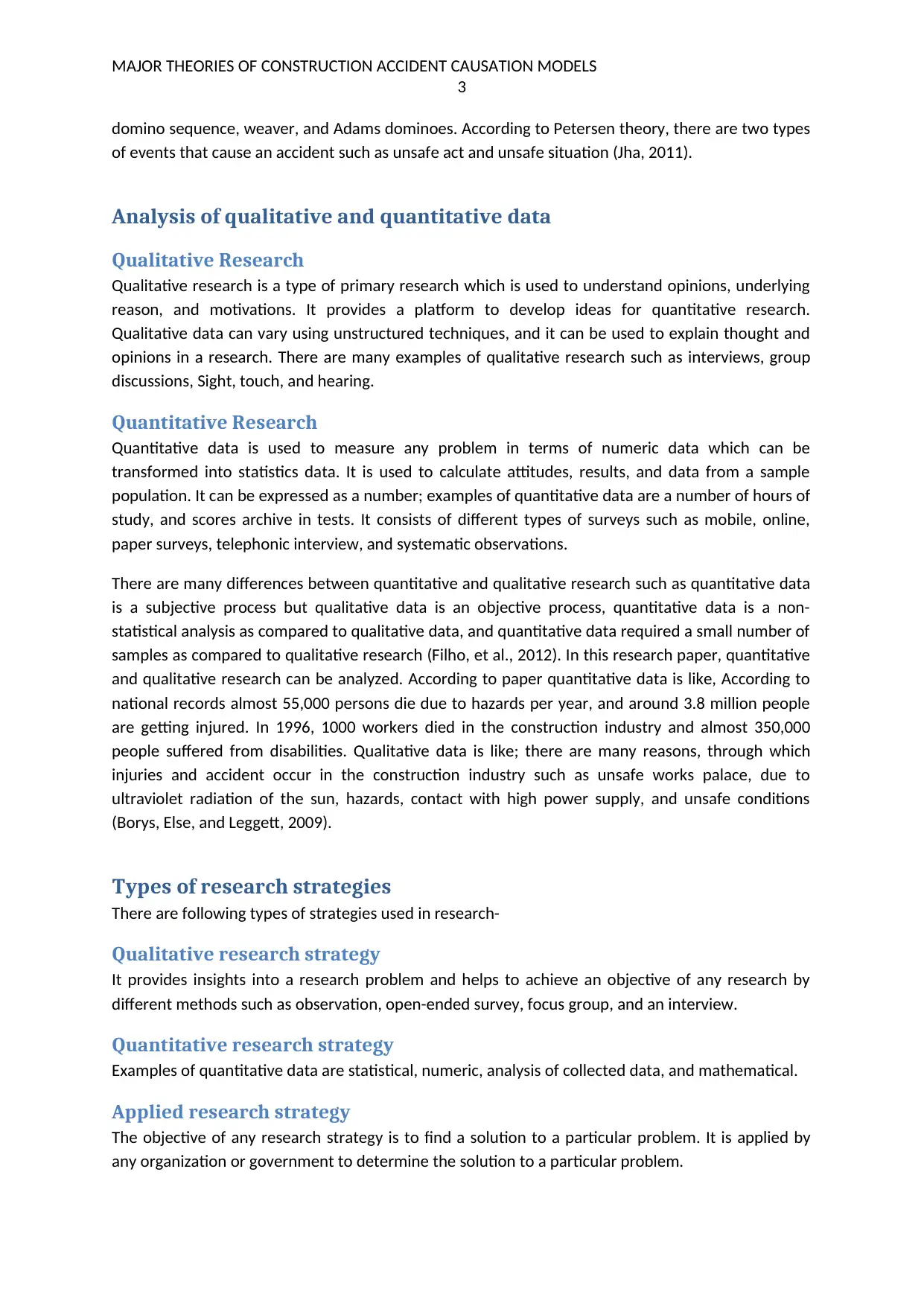
MAJOR THEORIES OF CONSTRUCTION ACCIDENT CAUSATION MODELS
3
domino sequence, weaver, and Adams dominoes. According to Petersen theory, there are two types
of events that cause an accident such as unsafe act and unsafe situation (Jha, 2011).
Analysis of qualitative and quantitative data
Qualitative Research
Qualitative research is a type of primary research which is used to understand opinions, underlying
reason, and motivations. It provides a platform to develop ideas for quantitative research.
Qualitative data can vary using unstructured techniques, and it can be used to explain thought and
opinions in a research. There are many examples of qualitative research such as interviews, group
discussions, Sight, touch, and hearing.
Quantitative Research
Quantitative data is used to measure any problem in terms of numeric data which can be
transformed into statistics data. It is used to calculate attitudes, results, and data from a sample
population. It can be expressed as a number; examples of quantitative data are a number of hours of
study, and scores archive in tests. It consists of different types of surveys such as mobile, online,
paper surveys, telephonic interview, and systematic observations.
There are many differences between quantitative and qualitative research such as quantitative data
is a subjective process but qualitative data is an objective process, quantitative data is a non-
statistical analysis as compared to qualitative data, and quantitative data required a small number of
samples as compared to qualitative research (Filho, et al., 2012). In this research paper, quantitative
and qualitative research can be analyzed. According to paper quantitative data is like, According to
national records almost 55,000 persons die due to hazards per year, and around 3.8 million people
are getting injured. In 1996, 1000 workers died in the construction industry and almost 350,000
people suffered from disabilities. Qualitative data is like; there are many reasons, through which
injuries and accident occur in the construction industry such as unsafe works palace, due to
ultraviolet radiation of the sun, hazards, contact with high power supply, and unsafe conditions
(Borys, Else, and Leggett, 2009).
Types of research strategies
There are following types of strategies used in research-
Qualitative research strategy
It provides insights into a research problem and helps to achieve an objective of any research by
different methods such as observation, open-ended survey, focus group, and an interview.
Quantitative research strategy
Examples of quantitative data are statistical, numeric, analysis of collected data, and mathematical.
Applied research strategy
The objective of any research strategy is to find a solution to a particular problem. It is applied by
any organization or government to determine the solution to a particular problem.
3
domino sequence, weaver, and Adams dominoes. According to Petersen theory, there are two types
of events that cause an accident such as unsafe act and unsafe situation (Jha, 2011).
Analysis of qualitative and quantitative data
Qualitative Research
Qualitative research is a type of primary research which is used to understand opinions, underlying
reason, and motivations. It provides a platform to develop ideas for quantitative research.
Qualitative data can vary using unstructured techniques, and it can be used to explain thought and
opinions in a research. There are many examples of qualitative research such as interviews, group
discussions, Sight, touch, and hearing.
Quantitative Research
Quantitative data is used to measure any problem in terms of numeric data which can be
transformed into statistics data. It is used to calculate attitudes, results, and data from a sample
population. It can be expressed as a number; examples of quantitative data are a number of hours of
study, and scores archive in tests. It consists of different types of surveys such as mobile, online,
paper surveys, telephonic interview, and systematic observations.
There are many differences between quantitative and qualitative research such as quantitative data
is a subjective process but qualitative data is an objective process, quantitative data is a non-
statistical analysis as compared to qualitative data, and quantitative data required a small number of
samples as compared to qualitative research (Filho, et al., 2012). In this research paper, quantitative
and qualitative research can be analyzed. According to paper quantitative data is like, According to
national records almost 55,000 persons die due to hazards per year, and around 3.8 million people
are getting injured. In 1996, 1000 workers died in the construction industry and almost 350,000
people suffered from disabilities. Qualitative data is like; there are many reasons, through which
injuries and accident occur in the construction industry such as unsafe works palace, due to
ultraviolet radiation of the sun, hazards, contact with high power supply, and unsafe conditions
(Borys, Else, and Leggett, 2009).
Types of research strategies
There are following types of strategies used in research-
Qualitative research strategy
It provides insights into a research problem and helps to achieve an objective of any research by
different methods such as observation, open-ended survey, focus group, and an interview.
Quantitative research strategy
Examples of quantitative data are statistical, numeric, analysis of collected data, and mathematical.
Applied research strategy
The objective of any research strategy is to find a solution to a particular problem. It is applied by
any organization or government to determine the solution to a particular problem.
Secure Best Marks with AI Grader
Need help grading? Try our AI Grader for instant feedback on your assignments.
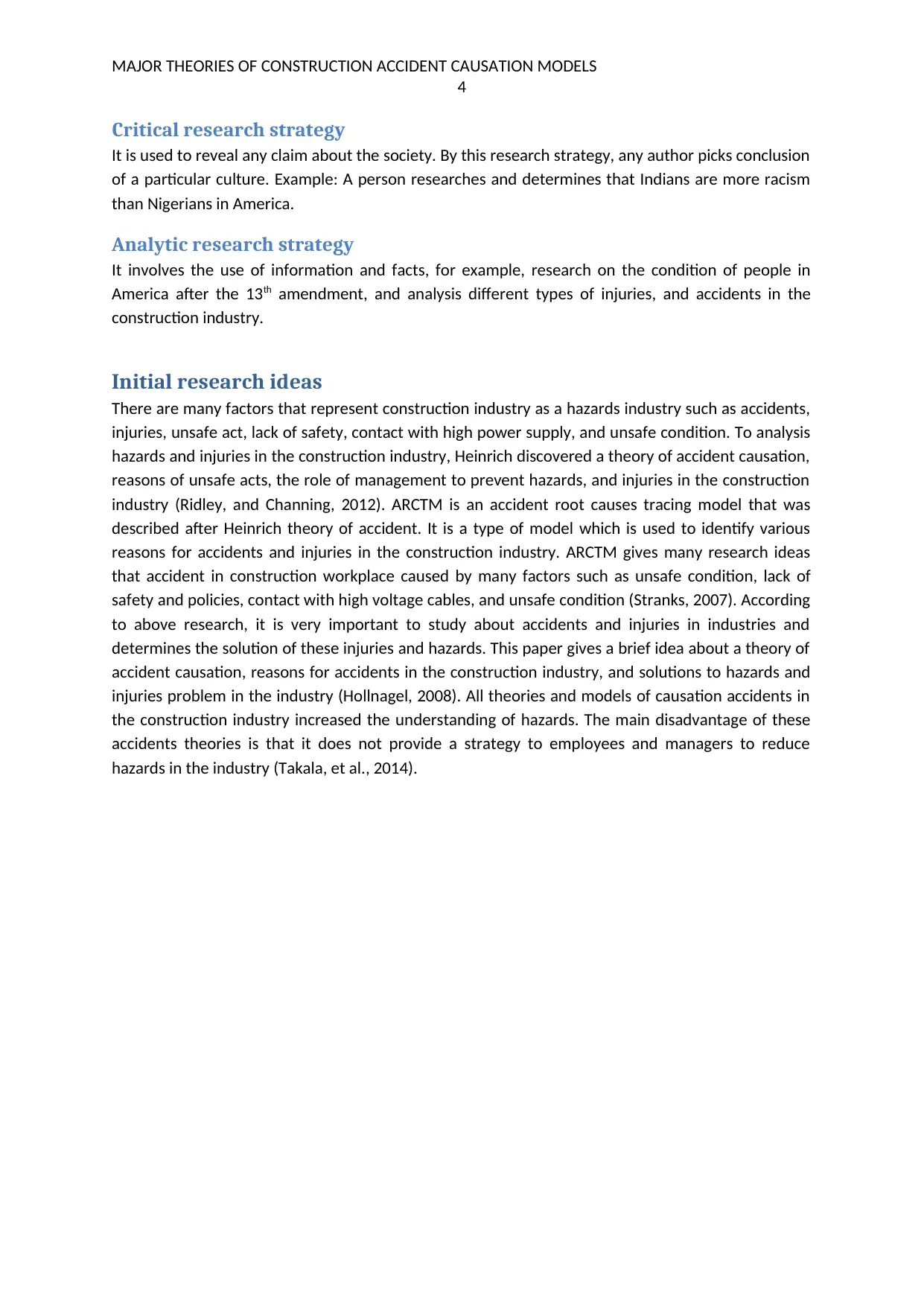
MAJOR THEORIES OF CONSTRUCTION ACCIDENT CAUSATION MODELS
4
Critical research strategy
It is used to reveal any claim about the society. By this research strategy, any author picks conclusion
of a particular culture. Example: A person researches and determines that Indians are more racism
than Nigerians in America.
Analytic research strategy
It involves the use of information and facts, for example, research on the condition of people in
America after the 13th amendment, and analysis different types of injuries, and accidents in the
construction industry.
Initial research ideas
There are many factors that represent construction industry as a hazards industry such as accidents,
injuries, unsafe act, lack of safety, contact with high power supply, and unsafe condition. To analysis
hazards and injuries in the construction industry, Heinrich discovered a theory of accident causation,
reasons of unsafe acts, the role of management to prevent hazards, and injuries in the construction
industry (Ridley, and Channing, 2012). ARCTM is an accident root causes tracing model that was
described after Heinrich theory of accident. It is a type of model which is used to identify various
reasons for accidents and injuries in the construction industry. ARCTM gives many research ideas
that accident in construction workplace caused by many factors such as unsafe condition, lack of
safety and policies, contact with high voltage cables, and unsafe condition (Stranks, 2007). According
to above research, it is very important to study about accidents and injuries in industries and
determines the solution of these injuries and hazards. This paper gives a brief idea about a theory of
accident causation, reasons for accidents in the construction industry, and solutions to hazards and
injuries problem in the industry (Hollnagel, 2008). All theories and models of causation accidents in
the construction industry increased the understanding of hazards. The main disadvantage of these
accidents theories is that it does not provide a strategy to employees and managers to reduce
hazards in the industry (Takala, et al., 2014).
4
Critical research strategy
It is used to reveal any claim about the society. By this research strategy, any author picks conclusion
of a particular culture. Example: A person researches and determines that Indians are more racism
than Nigerians in America.
Analytic research strategy
It involves the use of information and facts, for example, research on the condition of people in
America after the 13th amendment, and analysis different types of injuries, and accidents in the
construction industry.
Initial research ideas
There are many factors that represent construction industry as a hazards industry such as accidents,
injuries, unsafe act, lack of safety, contact with high power supply, and unsafe condition. To analysis
hazards and injuries in the construction industry, Heinrich discovered a theory of accident causation,
reasons of unsafe acts, the role of management to prevent hazards, and injuries in the construction
industry (Ridley, and Channing, 2012). ARCTM is an accident root causes tracing model that was
described after Heinrich theory of accident. It is a type of model which is used to identify various
reasons for accidents and injuries in the construction industry. ARCTM gives many research ideas
that accident in construction workplace caused by many factors such as unsafe condition, lack of
safety and policies, contact with high voltage cables, and unsafe condition (Stranks, 2007). According
to above research, it is very important to study about accidents and injuries in industries and
determines the solution of these injuries and hazards. This paper gives a brief idea about a theory of
accident causation, reasons for accidents in the construction industry, and solutions to hazards and
injuries problem in the industry (Hollnagel, 2008). All theories and models of causation accidents in
the construction industry increased the understanding of hazards. The main disadvantage of these
accidents theories is that it does not provide a strategy to employees and managers to reduce
hazards in the industry (Takala, et al., 2014).

MAJOR THEORIES OF CONSTRUCTION ACCIDENT CAUSATION MODELS
5
References
Abdelhamid, T. S., and Everett, J. G., (2000) Identifying root causes of construction accidents. Journal
of Construction Engineering and Management, 126 (1), pp.52-60.
Borys, D. M., Else, D., and Leggett, S. (2009) the fifth age of safety: The adaptive age. J Health &
Safety Research & Practice, 1, pp. 19-27.
Cite seer x (2012) MAJOR THEORIES OF CONSTRUCTION ACCIDENT CAUSATION MODELS: A
LITERATURE REVIEW. [online] Available from: http://citeseerx.ist.psu.edu/viewdoc/download?
doi=10.1.1.668.8949&rep=rep1&type=pdf [Accessed 03/07/18].
Filho, M. J., Fonseca, E. D., Lima, F. P., and Duarte, F. J. (2012) Organizational factors related to
occupational accidents in construction. Work, 41, pp. 4130-4136.
Hollnagel, E. (2008) the Changing Nature of Risks. Ergonomics Australia, 22, pp. 33-46.
Jha, K. N., (2011) Construction Project Management: theory and practice. South Asia: Dorling
Kindersley (India) Pvt Ltd.
Quinlan, M., Bohle, P., and Lamm, F. (2010) Managing occupational health in safety: a
multidisciplinary approach. 3rd ed. South Melbourne: Macmillan.
Ridley, J. and Channing, J. (2012) Safety at Work. Elsevier: Butterworth-Heinemann.
Stranks, J. W. (2007) Human Factors and Behavioural Safety. Elsevier: Butterworth-Heinemann.
Takala, J., Hamalainen, P., Saarela, K. L., Yun, L. Y., Manickam, K., and Jin, T. W. (2014) Global
estimates of the burden of injury and illness at work in 2012. Journal of Occupational and
Environmental Hygiene, 11, pp. 326-337.
5
References
Abdelhamid, T. S., and Everett, J. G., (2000) Identifying root causes of construction accidents. Journal
of Construction Engineering and Management, 126 (1), pp.52-60.
Borys, D. M., Else, D., and Leggett, S. (2009) the fifth age of safety: The adaptive age. J Health &
Safety Research & Practice, 1, pp. 19-27.
Cite seer x (2012) MAJOR THEORIES OF CONSTRUCTION ACCIDENT CAUSATION MODELS: A
LITERATURE REVIEW. [online] Available from: http://citeseerx.ist.psu.edu/viewdoc/download?
doi=10.1.1.668.8949&rep=rep1&type=pdf [Accessed 03/07/18].
Filho, M. J., Fonseca, E. D., Lima, F. P., and Duarte, F. J. (2012) Organizational factors related to
occupational accidents in construction. Work, 41, pp. 4130-4136.
Hollnagel, E. (2008) the Changing Nature of Risks. Ergonomics Australia, 22, pp. 33-46.
Jha, K. N., (2011) Construction Project Management: theory and practice. South Asia: Dorling
Kindersley (India) Pvt Ltd.
Quinlan, M., Bohle, P., and Lamm, F. (2010) Managing occupational health in safety: a
multidisciplinary approach. 3rd ed. South Melbourne: Macmillan.
Ridley, J. and Channing, J. (2012) Safety at Work. Elsevier: Butterworth-Heinemann.
Stranks, J. W. (2007) Human Factors and Behavioural Safety. Elsevier: Butterworth-Heinemann.
Takala, J., Hamalainen, P., Saarela, K. L., Yun, L. Y., Manickam, K., and Jin, T. W. (2014) Global
estimates of the burden of injury and illness at work in 2012. Journal of Occupational and
Environmental Hygiene, 11, pp. 326-337.
1 out of 6
Related Documents
Your All-in-One AI-Powered Toolkit for Academic Success.
+13062052269
info@desklib.com
Available 24*7 on WhatsApp / Email
![[object Object]](/_next/static/media/star-bottom.7253800d.svg)
Unlock your academic potential
© 2024 | Zucol Services PVT LTD | All rights reserved.





